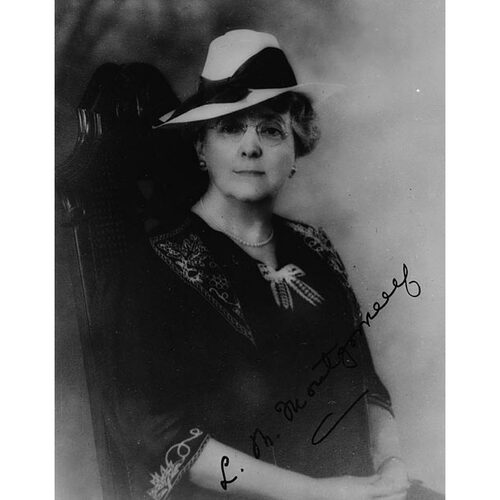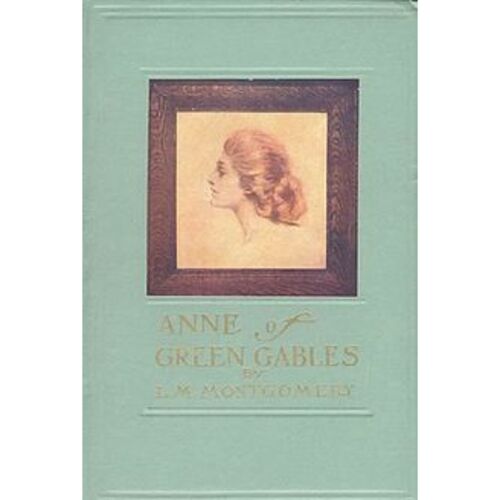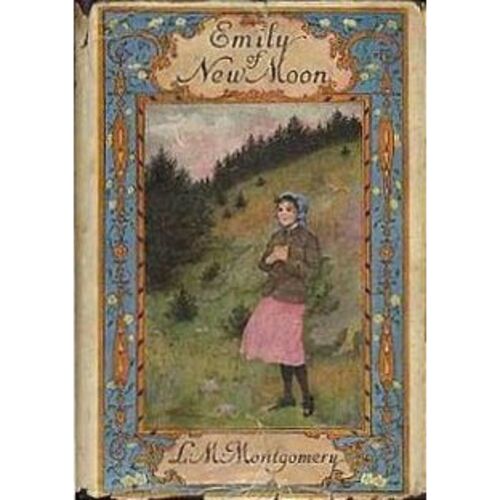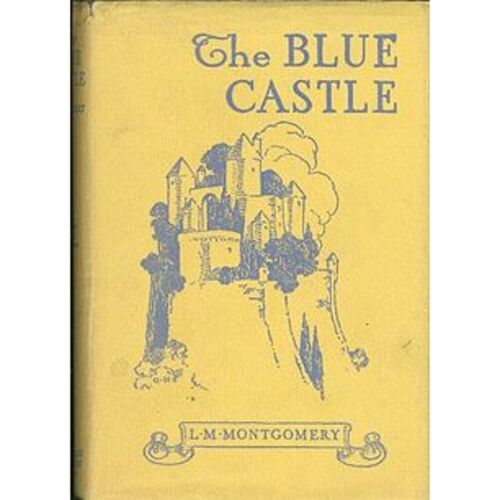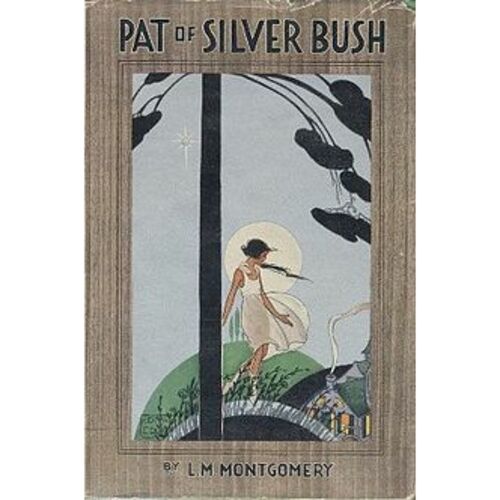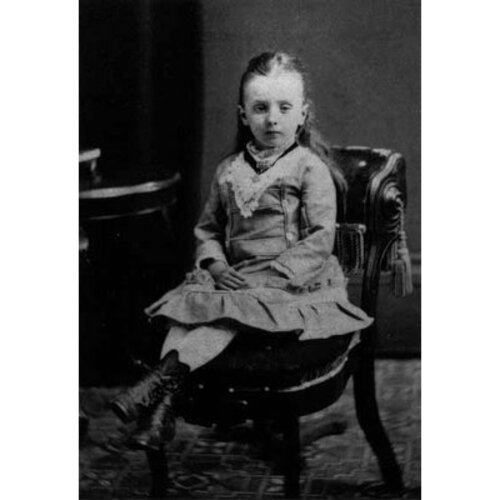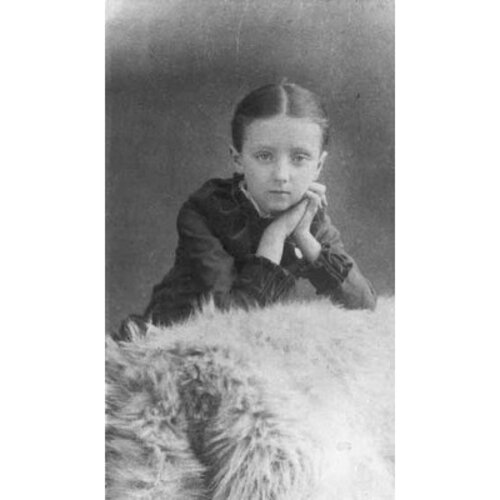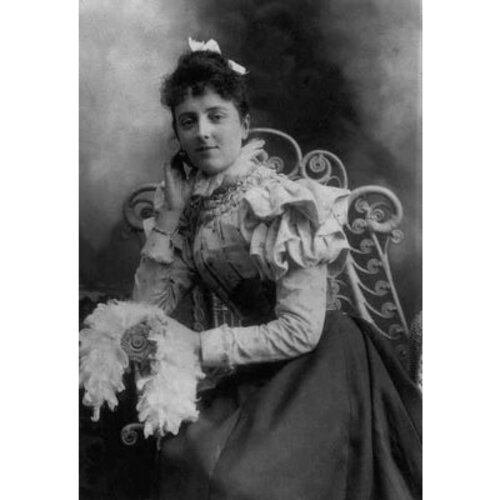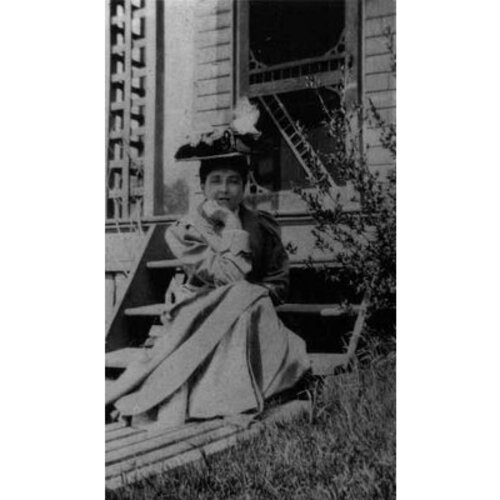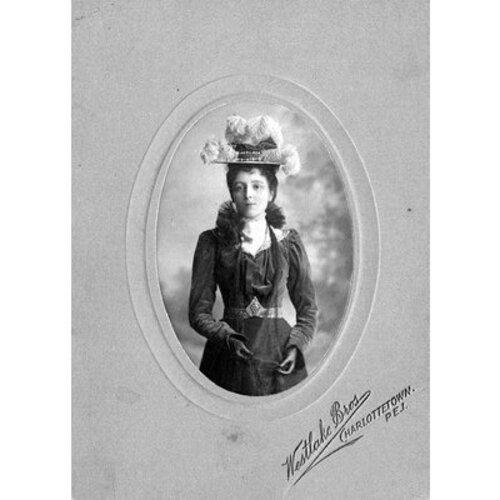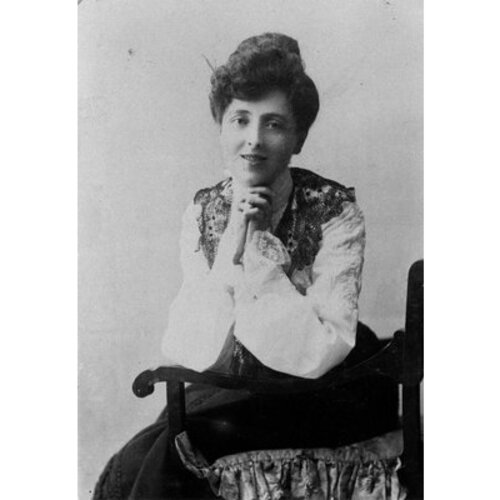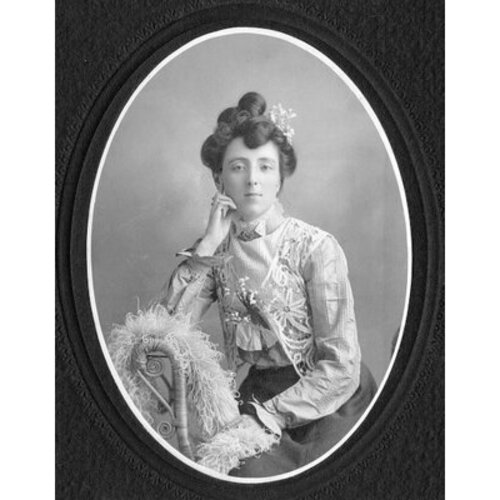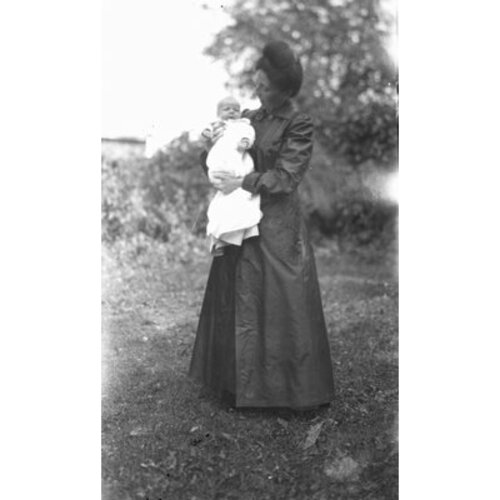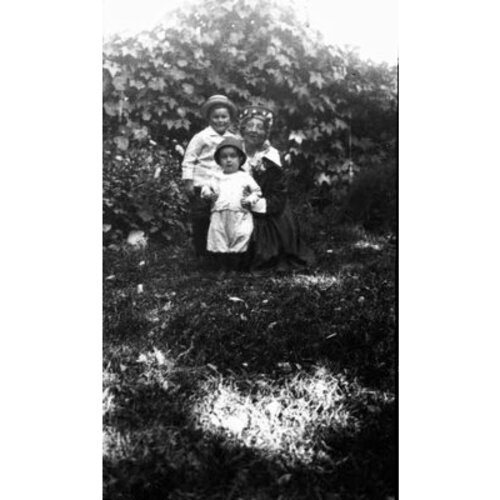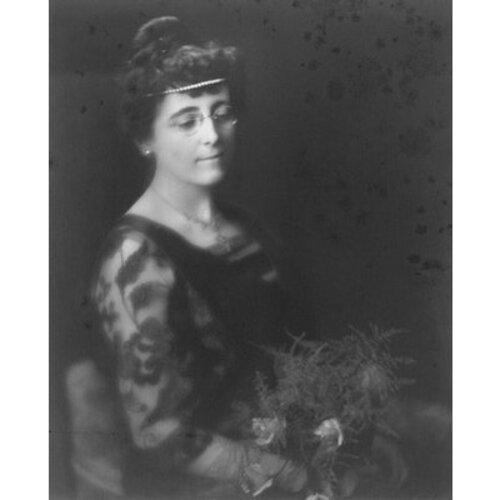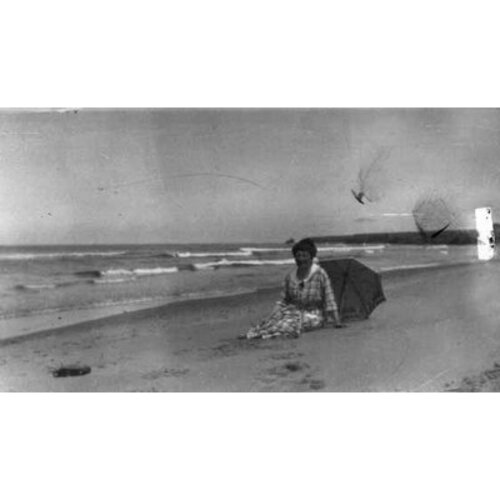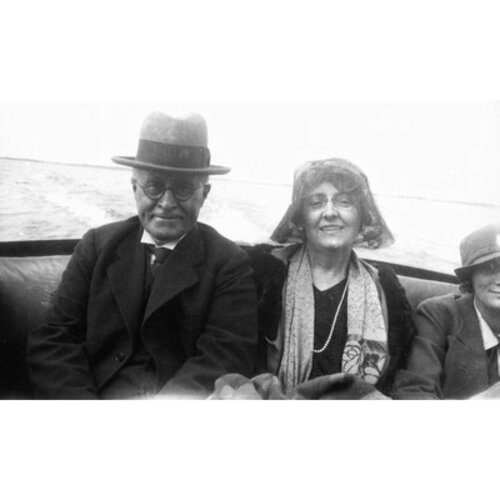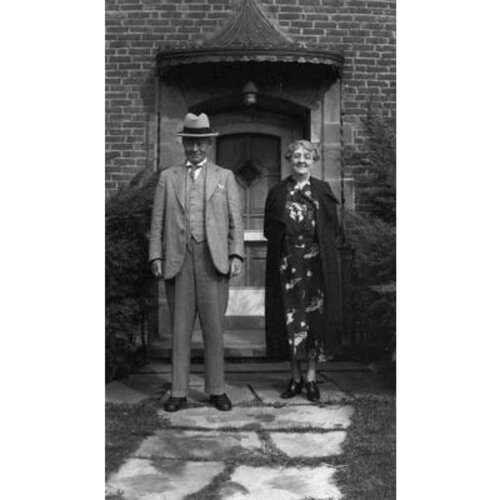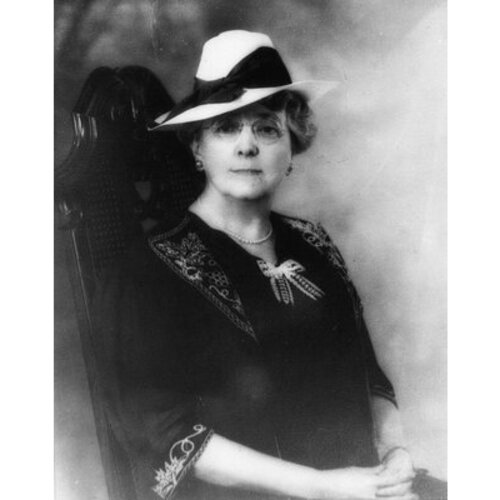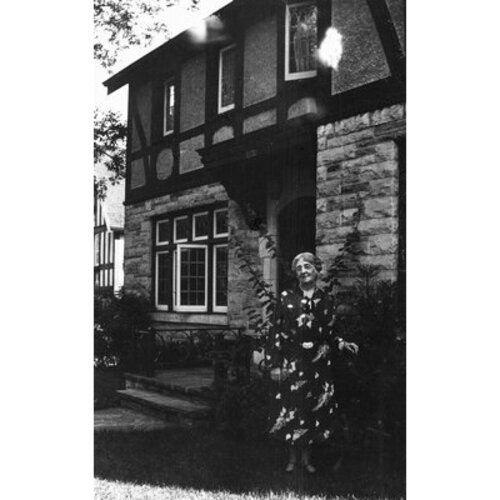
Source: Link
MONTGOMERY, LUCY MAUD (Macdonald), diarist, author, teacher, newspaperwoman, and public speaker; b. 30 Nov. 1874 in Clifton (New London), P.E.I., only child of Hugh John Montgomery and Clara Woolner Macneill; m. 5 July 1911 the Reverend Ewen (Ewan) Macdonald (d. 1943) in Park Corner, P.E.I., and they had three sons, the second of whom died at birth; d. 24 April 1942 in Swansea (Toronto) and was buried in Cavendish, P.E.I.
L. M. Montgomery, called both Lucy Maud and Maudie as a child and Maud as an adult (she once asserted that “my friends call me ‘Maud’ and nothing else”), was raised in Cavendish near the north shore of Prince Edward Island; under the fictional name of Avonlea, this beautiful rural community provides the setting for her most famous novel, Anne of Green Gables. She was born into two of the province’s most prominent landholding families. Both the Macneills and the Montgomerys boasted ties to distinguished clans in Scotland, some members of which were published authors, and they had relatives who were active in Island politics. As she matured, Maud was aware of tension between her “passionate Montgomery blood” and her “Puritan Macneill conscience.” She was also aware that she had been born to what Cavendish considered high status because her ancestors had long been settled in Canada, they had connections to the old country, and they had financial security and political influence. Her mother died of tuberculosis when she was 21 months old, and her energetic but feckless father left his daughter to be raised by her maternal grandparents, Alexander Marquis and Lucy Ann Macneill, who had been born a Woolner and thus belonged to another prominent Island family. Four years later he went to the Canadian west to seek his ever-elusive fortune, a parental abandonment that would provide Maud with the frequently used theme of orphanhood. Despite her pride in her background and her comfortable everyday life that included many playmates, Maud, as an adult, would look back on her childhood as a time when she believed that she had felt unwanted and unloved. She was a passionate, demonstrative girl, often wounded by Alexander’s sharp, sarcastic tongue and Lucy’s firm authority, and she soon realized that boys were given advantages and allowed to have ambitions that were considered unnecessary or unsuitable for girls.
Cavendish was a close-knit, self-sufficient, and rather isolated farming village, full of sober, hard-working, literate Scots and Scots-English. It had a fine school, two churches (Presbyterian, for which the Macneills had donated the land, and Baptist, which had been established by disgruntled Presbyterians), and a meeting hall for travelling speakers as well as a local literary society that brought in the newest books from the United Kingdom, France, and the United States. Maud had many cousins and other playmates, and despite the loss of her mother and the absence of her idolized father, her early childhood was happy and carefree, spent playing on the seashore, in the nearby fields, and in the scenic woods. Her fervent love of nature and the beauty of the Island would be prominent in her work.
Maud showed aptitude for writing and storytelling from a young age. Her life was in many ways ideal for a future novelist. The village post office was run out of the family kitchen, which gave the Macneills unique knowledge of their neighbours’ business. She was steeped in the Scottish oral tradition: she listened as local events, both past and current, were turned into stories by her grandfather, who was a masterful raconteur, and she internalized the structures and techniques of spoken narratives. There were daily readings from the King James version of the Bible and frequent recitations from the works of favourite poets. She also had access to more books than most children who lived outside urban centres owing to the family library, an innovative lending library, and a good school system. Her grandparents’ collection included the school readers that had been used by her aunts and uncles as well as books ordered by her family and those brought by her uncle Leander George Macneill, a brilliant and successful minister in Saint John, when he visited during summer holidays. She read voraciously and retentively, seeking out works by Scottish, English, and American writers, including Robert Burns, Sir Walter Scott, Sir James Matthew Barrie, John Bunyan, William Wordsworth, Lord Byron, Jane Austen, the Brontë sisters, George Eliot, Edward Bulwer-Lytton, Lord Tennyson, John Greenleaf Whittier, Henry Wadsworth Longfellow, and Mark Twain. Because most local families were related and had lived in Cavendish for several generations, Maud had much opportunity to observe patterns of kinship and the interaction of different personalities. Her early interest in writing, disparaged by relatives as “scribbling,” was discouraged in favour of more practical pursuits considered suitable for women. All her life she would resent her family’s ridicule of her youthful literary efforts and her attempt to find an outlet for her exceptional creative energies.
There were other damaging psychological burrs in her generally idyllic world. Her grandparents, who had already raised six children, were in their fifties when Maud joined their household, and their stern Scottish Presbyterianism became more rigid as they aged. Maud was a highly intelligent but moody and oversensitive child; as she grew up, her impulsive temperament became harder to manage, and her grandparents agonized over her behaviour and the resulting gossip. Like her later creation Anne Shirley, the volatile Maud moved between flights of fancy and the “depths of despair.” These extremes elicited some negative talk among aunts and uncles, and the more her grandparents tried to guide and control her, the more isolated, different, and persecuted she felt. She had idealized her father, but after she spent 1890–91 with him and his new family in Prince Albert (Sask.), she had to face the fact that he cared little about her welfare. His wife, Mary Ann McRae, niece of railway magnate William Mackenzie*, was 23 years younger than her husband, had given birth to a daughter, and was three months pregnant when Hugh’s first child came to stay in August. Hostile to her psychologically needy stepdaughter, she made Maud’s life miserable, pulling her out of school to tend the children and help with housework. Having found neither welcome nor support, 16-year-old Maud left in August 1891 to return to her grandparents’ home. However, while in Prince Albert, she had published her first piece – a poem – in the Patriot (Charlottetown), which gave her hope that she might become a professional author. Her early writing shows much sophistication and stylistic grace. She would later claim that it was during this period that she “had learned the first, last, and middle lesson – ‘Never give up!’”
Back in Prince Edward Island, she assessed the bleak future that faced women who did not marry, and chose the traditional path of studying to become a teacher. An excellent student, she took two years of training in one (1893–94) at Prince of Wales College in Charlottetown, then headed by Alexander Anderson*. Long afterwards, she would describe this period as “the happiest year of my life.” Now holding a licence, she found a position in Bideford. In July 1894 she began working with 20 children ranging in age from 6 to 13; she was a talented teacher, and would eventually have 60 pupils. With the discipline that characterized her all her life, she devoted part of each day to writing fiction and poetry for newspapers and magazines, a trade that was expanding rapidly because of increased public literacy and new methods of transporting printed materials.
It was expected that young women would teach until they met someone to marry, and then settle down to raise a family. Instead, Maud saved her money, and with financial help from her grandmother she was able to attend Dalhousie College in Halifax in 1895–96. Her most influential instructor was Archibald McKellar MacMechan*. A pioneer in promoting Canadian literature, he recognized his student’s talent, and she found his praise extremely heartening. In addition to working on her courses, she continued writing and achieved more publishing success. It was a year of intense physical, mental, and social activity, but she lacked the money to continue her education (and bitterly resented the fact that her cousin Murray Macneill, a gifted polymath who was also a student at Dalhousie, would receive assistance and encouragement to extend his studies). Returning to the exhausting occupation of poorly paid teaching in rural communities, she moved first to Belmont (1896–97), where she became engaged to an intelligent, attractive, attentive cousin, Edwin Simpson. She was lonely and wanted the affection of a husband and the happiness of children, and, believing that he intended to become a lawyer, she thought that marriage to a professional would give her the financial security to pursue a writing career. Yet she soon found him physically and emotionally repellent. She felt trapped, and, increasingly aware of her extreme mood swings, craved stability and structure. She taught in Lower Bedeque in 1897–98, and there she fell tumultuously in love with a young farmer, George Herman Leard (he was always known by his second name), who may have been engaged to someone else. In the spring she wrote to Ed to ask for her freedom. Throughout this extremely difficult period she steadily sold poems and stories to periodicals in Canada and the United States.
Maud was certain that she could make a living as an author if she could write full time. In March 1898 the fractious Alexander Macneill died suddenly. This event offered her an escape from the painful relationship with Herman, whom, she declared in her journal, she “could never marry,” and the frustration of teaching. She returned to her beloved Cavendish to live with her widowed grandmother, who had always been sympathetic, even if she did not understand Maud’s motivations and highly volatile temperament. Maud won respect from the community by caring for her elderly grandmother, and in the safe, familiar environment she had more time to write. By running the post office from the kitchen, she had continuous access to the local pulse and gossip – from which she created the substance of her books – and she could send out materials to publishers without anyone knowing about it.
The years from 1898 to 1911 turned out to be a golden period in which Maud firmly established herself as a professional. She published hundreds of stories and poems as well as her first and most famous novel, the perennial best-seller Anne of Green Gables (1908). In one nine-month interlude (September 1901 to June 1902) she worked in Halifax for the Daily Echo as a proofreader and journalist, but after her uncle John Franklin Macneill tried to oust his ageing mother from the house where she had lived all her married life, Maud was happy to return to do battle on her grandmother’s behalf. She wanted to marry and, eventually, have children, but there were no appropriate suitors in Cavendish. Then, in 1903, the new-minted Reverend Ewen Macdonald was hired as the local Presbyterian minister. Four years older than she was, this reserved, stiff, diffident Gaelic speaker, whose paternal grandparents had left the Isle of Skye, Scotland, and settled in Bellevue on the other side of the Island, was taken with Maud’s exceptional charm, sense of humour, witty conversation, and storytelling ability. She was attracted by Ewan (as she spelled his name), who was kind and good-tempered, and they became secretly engaged on 12 Oct. 1906. They agreed that marriage would wait until after the death of Lucy Macneill. Buoyed by this commitment and confident of his future, Ewan left for additional training at the University of Glasgow. Once in Scotland, however, he felt socially awkward and intellectually inadequate, and soon collapsed with a nervous breakdown. His few, puzzling letters alarmed his fiancée. He returned home in early spring 1907 without further credentials, and he eventually found a post in a community so remote from Cavendish that he and Maud could not spend time together and get to know each other better.
Like Ewan, Maud had been stimulated by their courtship and engagement, and the high spirits engendered by romance had produced the manuscript of Anne of Green Gables. In 1917, in a series of articles published by Everywoman’s World and later reissued as a monograph called The alpine path, she would write that Anne was rejected five times before being accepted in 1907 by the L. C. Page Company of Boston, which also published works by Canadians Margaret Marshall Saunders, Charles George Douglas Roberts, and William Bliss Carman*. The story of Anne Shirley, a clever, imaginative, loquacious orphan sent by mistake to an elderly brother and sister who had wanted a boy, the novel was a runaway success. Although there are extant copies with the publication date of April 1908, Maud received her first copy on 20 June; on the 30th the company’s head, Louis (Lewis) Coues Page, announced that the overnight best-seller had gone into a second printing. Maud found herself famous and sought after, and could look forward to a secure career. Her works attained immediate popularity outside Canada, with Dutch and Swedish translations appearing within a year. Page was eager for a sequel, and Anne of Avonlea, released in 1909, had huge sales. Kilmeny of the orchard, cobbled together from material published earlier in magazines, came out in 1910. That fall Maud was invited to meet the governor general, Lord Grey*, an enthusiastic admirer who came to the Island on a tour of Canada. Members of his entourage included physician and poet John McCrae* and McGill University classics professor John Macnaughton, a colleague of Islander Andrew Macphail*, and it was at Macphail’s homestead at Orwell that the gathering took place.
Despite enjoying her success, Maud was developing substantial worries about the mental health of the man she had agreed to marry. She herself experienced erratic changes of mood and outlook characterized by insomnia, exhaustion, and frantic mental restlessness, which frightened her. In 1910, wanting advancement, Ewan obtained a position in Leaskdale, a rural settlement north of Toronto, where he served two parishes. After Lucy Macneill died the following year, he and Maud married, and, funded by her immense royalties, they began an extended summer honeymoon in Scotland and England. She sought out scenes from her favourite poems and novels, and met Scottish journalist George Boyd MacMillan, with whom she had been corresponding since 1903. She would exchange letters with him and with Ephraim Weber, a teacher in western Canada, until shortly before her death. In such correspondence she found intellectual stimulation that, she eventually learned, she would not get from her husband.
The last 31 years of Maud’s life were spent in Ontario, but she frequently returned to her native province – “the only Island there is” – and nearly all her novels are set there. The exception is The Blue Castle, placed in Ontario’s Muskoka district where the Macdonalds would vacation in the 1920s. Although Jane of Lantern Hill begins in an unwholesome Toronto, the story moves to the restorative Island. Some of her later books draw on characters and events from her husband’s Ontario parishes, such as A tangled web, or were influenced by Toronto friends such as Dr Helen MacMurchy*, who was probably a model for the physician in Magic for Marigold. Maud quickly grew into her new position as mistress of the manse, organizer of most church events, and participant in many community associations. She wrote diligently for several hours every morning. To satisfy Page, who was making a fortune from her works, she agreed to yet another book about Anne although she had become tired of the character and usually found sequels a chore, and she continued to send short pieces to magazines. In 1911 her novel The Story Girl came out, followed in 1912 by Chronicles of Avonlea, a collection of short stories that she reworked to feature Anne in minor roles. She made trips to Toronto, where she gave speeches to organizations such as the Canadian Women’s Press Club and was feted by the literary establishment, which included Marjory Jardine Ramsay MacMurchy*, who took Maud under her wing, and Mary Esther MacGregor [Miller*] (Marian Keith), who would be one of Maud’s co-authors for Courageous women, a compilation of biographies. The Macdonalds started their family the year after their marriage with the birth of Chester Cameron. Hugh Alexander died at birth in 1914, and the third son, Ewan Stuart, arrived in 1915. Although a diminutive woman, Maud had phenomenal energy, and life in the manse was relatively settled and happy until World War I broke out, taking away many young men from their community and causing enormous social upheaval and stress throughout the country. Her journals for the four years of the conflict are full of anguished reactions to bad news from the front and joyous gratitude for Allied advances.
The war period brought Maud another anxiety: she began to realize that her publisher was dishonest. After her contract expired in 1915 and Page refused to publish a volume of her poetry, she had begun to look elsewhere. She chose as her publisher the gentlemanly Canadian John McClelland*, a co-founder of the firm that would become McClelland and Stewart. In an era when women did not normally stand up for their rights, especially in courts of law, Montgomery sued the arrogant, bullying Page for non-payment of royalties and damages for fraudulently selling the reprint rights to Anne’s house of dreams, which had been brought out by McClelland in 1917. So began more than a decade of suits and countersuits. When it became clear that Maud would not back down, Page tried other tactics and offered a deal. Eager to sever all contact, in 1919 she sold him all the rights to the seven books he had already published, together with rights to some unpublished stories, for almost $18,000. At the time this was a very large sum, but in the end the deal proved to be disastrous because her books, especially those she had written during the early part of her career, continued to sell well. Yet despite this agreement the lawsuits dragged on, creating constant tension, and Page managed to tie up her American royalties, threatening her income.
There were other disruptions. Maud was devastated by the death of her dearly loved cousin Frederica Elmanstine McFarlane, the most important of the “kindred spirits” who enriched her life, during the influenza pandemic of 1919. Church politics entered a period of turmoil that, in 1925, resulted in the creation of the United Church of Canada [see Clarence Dunlop Mackinnon*], which brought together the Congregationalists, the Methodists, and many Presbyterians. Both of Ewan’s congregations voted to remain out of the new church. This decision pleased him, and Maud, who had foreseen that he would find the effects of union extremely difficult, was pleased for him. She herself was indifferent, writing in her journal that “the Spirit of God no longer works through the church for humanity.… Today it is working through Science.… The [church] ‘leaders’ are trying to galvanize into a semblance of life something from which life has departed.” Ewan was also drawn into a lawsuit following a car accident, and the verdict, delivered by Toronto judge William Renwick Riddell, went against him. There was mean-spirited local gossip about Maud’s lifestyle (she not only had a successful career, but was also able to afford a maid) and her friendship with the dashing Reverend Edwin Smith, a former classmate of her husband’s and a United Church minister (originally Presbyterian) who had served with distinction during the war. Not surprisingly, the Macdonalds eventually wanted to move on, even though they had been much loved in the Leaskdale community. After 1919 Ewan had experienced mental disturbances (he suffered from clinical depression and had symptoms of schizophrenia, such as hearing imaginary voices), and they hoped a change would be stimulating for him.
In 1926 Ewan was called to a community west of Toronto that had been fractured by church-union politics. The Macdonalds took over a splendid brick manse in the charming hamlet of Norval (Halton Hills), located in the picturesque Credit River valley. It was a perfect place to raise young boys, and the family was initially very happy. Ewan once more had a double charge, and Maud became intensely involved in church events and fund-raising while continuing her writing and keeping up with literary events in Toronto. Greatly in demand as a speaker, she often chose books or her beloved Island as her topic, and enjoyed reading from her publications and reciting poetry. During the 1920s she pursued her litigation against the L. C. Page Company. All five suits were finally settled in her favour by October 1928. She invested the proceeds (about $4,000 after her lawyers were paid), only to lose the money and much of her savings in the stock-market crash of 1929. Unfortunately, Page had been able to finance his legal fights with income from the titles he had purchased from her in 1919, and he had not told her that he had sold the rights to Anne of Green Gables for the Hollywood silent movie starring Mary Miles Minter before pressuring her to relinquish her rights. While her sense of justice gave her the toughness to fight for fair treatment, the costs were nevertheless staggering, and the combat cut deeply into her income, family life, emotional reserves, and writing time.
Maud loved the beauty of Norval and its proximity to Toronto, where she maintained a cherished relationship with the developing literary culture. Her fame had surged after the war, and she was made a fellow of Great Britain’s Royal Society in 1923. She became active in the Canadian Authors Association (CAA), which brought her into contact with writers and editors such as Helen Letitia McClung [Mooney*] and Bernard Keble Sandwell*. Her earnings enabled her to send her sons to St Andrew’s College, an excellent secondary school in nearby Aurora. The Macdonalds hoped to settle permanently in Norval, which had many of the charms of Cavendish. But eventually things soured in this community, too. Ewan’s depression became debilitating, and he took more and more medication which, it is now known, probably made his condition worse. In 1934 he would spend almost two months in the Homewood Sanitarium [see Stephen Lett*] in Guelph. Their elder son, Chester, although undeniably bright, did poorly at university (for which his mother paid) because of behavioural problems that had been manifest since his earliest years; to the horror of his parents, he secretly married in November 1933 and became a father six months later. The younger son, Stuart, an outstanding student and award-winning gymnast, was attracted to a local girl of whom Maud had a low opinion. In her fiction she had described the unhappy consequences of older people meddling in the romances of their juniors, but she did not hesitate to try to influence her own children’s relationships. In 1935 Ewan, who was often unable to fulfil his duties because of his illness, resigned after a misunderstanding with the church elders about his salary, and retired. The Macdonalds moved to Swansea at the western edge of Toronto, where both their sons were now studying, and Maud purchased the only home she ever owned, a large brick house at what was then 210A Riverside Drive in a new enclave of prestigious residences on a cliff above the Humber River. She named it Journey’s End.
Maud had long looked forward to being freed of parish duties and becoming more involved in the Toronto book world through the CAA and the Canadian Women’s Press Club. She had worked hard to promote young Canadian authors in a period of heady post-war nationalism. The profits from her works helped McClelland and Stewart publish many upcoming writers, and the company would eventually bill itself as “the Canadian publisher.” More honours were won by their best-selling novelist. In March 1935 she learned that she had been elected to the Institut de France, and in May that year she received a letter from Prime Minister Richard Bedford Bennett informing her that she had been made an officer of the Order of the British Empire. These first years in Swansea were comparatively happy for Maud and Ewan, with their sons again living with them while taking courses at the University of Toronto (Chester’s wife and daughter remained with his father-in-law). But Chester, who was pursuing law, increasingly troubled both Maud and Ewan; he proved a huge disappointment and a continual worry in their final decade. Stuart enrolled in medicine and would become a well-known doctor in Toronto. Yet even their “one good son” dismayed his parents by skipping classes to play cards, and he failed his second year. Mortified by the experience, he settled down and did well.
Maud and her work were adored by readers around the world. But she realized that her style of writing was beginning to fall out of fashion with post-war critics. In October 1928 she noted ruefully that reprints of her previously published books continued to sell well, but their popularity worked against the success of her new, more expensive productions. To make matters worse, she had lent a great deal of money to members of her extended family (most was never repaid), and was under pressure to keep publishing for financial reasons. Her reputation was coming under increasing attack. The ambitious journalist and critic William Arthur Deacon* disparaged her novels as examples of Victorian sentiment and style that had no place in modern Canadian literature; in 1926 he had stated flatly that “Canadian fiction was to go no lower” than the books by L. M. Montgomery. His opinion was shared by others such as Oscar Pelham Edgar, one of the CAA’s founders, and Frederick Philip Grove, whose early work Maud had encouraged. In a manoeuvre that devastated her, Deacon had her ousted from the CAA executive in 1938. The diminution of her professional status and income during the decade of the Great Depression, together with acute family stresses caused by Ewan’s mental illness and Chester’s personal and professional failures, brought about a clinical depression in Maud. Like her husband, she was treated with barbiturates and bromides whose damaging secondary effects were not then understood. Also like Ewan, she became increasingly reliant on larger doses of prescription drugs; in addition, their well-meaning family physician administered hypodermics. The resulting downward spiral in her physical, mental, and emotional health after 1937 made it difficult for her to concentrate on writing, which cut her off from one of the fundamental joys of her life and caused a serious reduction in her earnings. Her work brought in more than $350,000 during her lifetime, a considerable sum for the period, but her generous gifts and loans as well as financial losses during the depression caused worry in her last years. The outbreak of World War II brought the fear that Stuart would be compelled to serve and intensified her distress. She died on 24 April 1942 after a long period of illness characterized by anxiety, depression, and severe weight loss.
The actual cause of her death is uncertain. Unfamiliar with her journal-writing process, her son Stuart, now a physician, mistook a sheet of writing dated two days before her death for a suicide note. For some time Maud had been typing transcriptions of each of her ten handwritten journals. The last page of the typed copy of the ninth journal was numbered 175. The supposed suicide note, numbered 176, reads: “This copy is unfinished and never will be. It is in a terrible state because I made it when I had begun to suffer my terrible breakdown of 1940. It must end here. If any publishers wish to publish extracts from it [the text of the typed copies of the first nine journals] under the terms of my will they must stop here. The tenth [handwritten] volume [of which she had typed only a few pages] can never be copied and must not be made public during my lifetime. Parts of it are too terrible and would hurt people. I have lost my mind by spells and I do not dare to think what I may do in those spells. May God forgive me and I hope everyone else will forgive me even if they cannot understand. My position is too awful to endure and nobody realizes it. What an end to a life in which I tried always to do my best in spite of many mistakes.” The cause of her death was recorded by Richard Arthur Gordon Lane, the attending family doctor, as “coronary thrombosis” attributed to “arteriosclerosis and a very high degree of neurasthenia,” a term used to describe nervous illness. There was no autopsy. Neither her son nor her doctor wanted an investigation: a suicide in that era would have cast shame on both the family and their physician. If there was indeed a drug overdose, as they thought, it remains unclear whether it was intentional or accidental, and the exact cause of Maud’s death will never be known. Ewan died the following year and was buried beside her in Cavendish.
Lucy Maud Montgomery’s place in the literary canon in Canada shifted enormously during the 20th century. Before World War I she was lionized by readers around the world, and her admirers included two men, Stanley Baldwin and James Ramsay MacDonald, who became prime ministers of Great Britain, as well as her fellow writer Mark Twain. Her name was familiar wherever English was spoken, and by 1925 her books had been translated into Swedish, Dutch, Polish, Danish, Norwegian, Finnish, and French. (According to scholar Benjamin Lefebvre, Anne; ou les illusions heureuses appeared in Geneva in 1925; French versions of her works originating in Canada were not released until the 1980s.) Her readers came from all age groups. Reviewers praised her books as delightful regional romances, imbued with a strong sense of place, skilful characterization, shrewd insights into human nature, and witty social criticism.
But after the war Modernism fostered a different style and subject matter. The change in literary standards and tastes meant that her work began to fall into disfavour with critics trying to distinguish between what they called “highbrow” and “lowbrow” literature. Missing the underlying seriousness of her stories because of their humour and conventional plots, male reviewers and academics – especially Canadians annoyed by her popularity – usually decried her writing as “sentimental” and “naive,” suitable only for women and children. They and, increasingly, sophisticated readers (and those who wished to be considered sophisticated) wanted a tough, hard-edged, pared-down approach as well as gritty content that seemed appropriate to a rapidly changing world dealing with war, criminality, sexual anxiety, urbanization, and the many other stresses of modernity. Montgomery herself preferred works by authors such as Sir Walter Scott, J. M. Barrie, the Brontës, and the English Romantic poets. In a letter to Ephraim Weber (29 April 1929) she wrote amusingly, and acidly, of a novel that met Modernist criteria, Morley Edward Callaghan*’s Strange fugitive (New York, 1928), and in a journal entry a few months earlier she had declared that the younger writer was without “vision, imagination … [or] insight” as well as being “deadly dull.” Her own writing, although full of energy, did not fit the new creed. Her focus was on the lives of women and children; her narrative style was grounded in the Scottish oral tradition of storytelling; her tone showed bemused benevolence towards human nature’s prejudices and power struggles. She delivered her tales with wit, sensuous splashes of purple prose, and the happy endings of traditional romance. She disliked the need to “drag [in] a ‘moral,’” but from her earliest days as an author she recognized the need to fulfil audience expectations; even in 1924 she felt that she “must cater to it [the public] awhile yet.”
Montgomery made some effort to demonstrate her awareness of the changing times. In The Blue Castle (1926), her one novel set entirely in Ontario (in the community of Bala, scene of the Macdonalds’ 1922 vacation), an unwed mother is one of the characters, and the novel’s heroine proposes to a man who has shown no romantic interest in her and is, moreover, thought by her family and community to be a “jail-bird.” Three years later, in Magic for Marigold, a woman physician is portrayed as continuing her career after her marriage. Montgomery was frustrated by the demands of her publishers and readers for conventional plots and tidy resolutions, and while writing Emily climbs she lamented in her journal (20 Jan. 1924) that she could not depict Emily Byrd Starr (another orphan) as being subject to normal adolescent sexual urges. Ironically, and surprisingly, what she once modestly called “simple little tales” have occasionally been seen as subversive or dangerous books; for example, The Blue Castle sold well, yet it was banned by some libraries.
The dismissive view of the Canadian literary establishment prevailed until the last quarter of the 20th century, despite Montgomery’s continuing popularity in her own country and around the world. When critical approaches such as feminism and cultural studies dismantled the earlier norms that had excluded women’s fiction and popular writing, her oeuvre came under new scrutiny, and she has moved into a secure spot in Canada’s literary history. Many women authors working in the second half of the 20th century, such as Alice Munro and Jean Margaret Laurence [Wemyss*], have described her influence on their choice of career as well as their subject matter. Women in other professions also speak of her impact on their sense of self and personal worth in a patriarchal society. Montgomery’s fans continue to reread her books, responding to their energy and finding fresh insights and relevance at various stages of their lives.
Montgomery’s enduring appeal seems to have different sources in different countries. In Sweden, where her books have sold well since 1909, her humour, her emphasis on women’s value, and her understanding of human psychology are particularly appreciated. During World War II the publishing wing of the Polish army is reputed to have issued Anne of the Island to soldiers because it provided a powerful image of happy domesticity worth fighting for. After the war the Soviet government attempted to ban her books in Poland, apparently because they believed that Montgomery’s writings encouraged loyalty to friends and family rather than to the state. Despite this censure, The Blue Castle is the basis for a 1982 musical with a political subtext featuring the triumph of the powerless over authority. Interest in her works is not confined to North America and Europe. In 2012 the Publishers Association of China listed Anne of Green Gables as one of the 50 most influential novels available in the country. In Japan missionary Loretta Leonard Shaw* gave a copy of Anne of Green Gables as a parting gift to a Japanese friend in 1939, and thus set into motion the immense popularity of the Canadian’s books in that country. Some readers there believe that Montgomery reinforces the idea that women should value devotion to family more than their self-development, but others argue that she encourages women to speak up for themselves.
The Japanese have also reacted with astounding enthusiasm to Montgomery’s descriptions of nature in her native province, and for decades they have been among the most numerous of the thousands of tourists who each year visit Prince Edward Island National Park, which opened in 1937 with “Green Gables” as its centrepiece. Whatever the origins of her fascination, L. M. Montgomery was her country’s most influential cultural ambassador during the 20th century; Canadian academics travelling and teaching abroad from the 1960s through the 1980s were often surprised to find that Montgomery, either in English or in translation, was the only Canadian writer known in many nations.
At the same time that critical norms were being reformulated, selections from Montgomery’s ten handwritten private journals, which she kept from 1889 until the year of her death, were published. They show a highly intelligent, well-read woman with a sophisticated sense of history, keenly aware that the isolated, intensely religious, agrarian world in which she had been raised was passing away because of industrial development and the Great War. In 1919 she began copying and shaping the journals, determined to document this massive social change as well as her place in it. She also recorded many things that she could not utter publicly since, as a minister’s wife, she had to be both discreet and tactful. The journals served as the “refuge” of her “sick spirit,” consuming the “smoke” that arose from her turbulent emotions. Readers have been startled to find that Montgomery suffered from extreme mood swings exacerbated by her late-life marriage to a depressed and hypochondriac husband. Also unexpected are the sharp pen and judgemental nature of a woman whose novels are so humorous and tolerant of the quirks in human nature. Readers feel sympathetic as she tries to compensate for her husband’s failings by working extra hard at organizing church social and fund-raising events and arranging for others to fill in when he is unable to carry out his duties. They admire her encouragement of other writers. They are astonished by her energy and efficiency as she fulfils her roles as wife, mother, minister’s helper, supporter of her extended family, friend, professional writer, and popular speaker.
Yet it is important to understand that the author of the journals presents herself as she wanted to be remembered. Rightly or wrongly, she came to depict herself as the victim of a cruel fate, giving a tragic aspect to the protagonist of these documents, which she intended to be published long after her death. While they provide a chronological journey through her life, as well as many psychological insights, there are serious omissions, particularly about her private doubts and her increasingly difficult family life. For instance, she worries (without amplification or exploration) about her role in her own misfortune, wondering if elements in her character or some of her actions have brought trouble on loved ones and herself. Canadian historian J. M. Bumsted has declared that the greatest literary character Montgomery created was her own self in her journals.
For Montgomery, writing was a profession: in December 1903 she told George MacMillan that “I am frankly in literature to make my living out of it.” From the time she realized that publishers would pay for poetry and fiction, she was determined to earn her way as an author. Her journals and her letters trace her growing skill and pride in her improving artistry and rising income. But writing was also a joy. In The alpine path she quotes her journal entry of 23 Aug. 1901: “But oh, I love my work! I love spinning stories, and I love to … shape some ‘airy fairy’ fancy into verse.” She could express something of what she glimpsed of “a kingdom of ideal beauty,” hidden by “only a thin veil.” Her creativity, fundamental to the passionate nature that was “the gift of wings,” sustained her through many ups and downs in her life. She delighted in the fame and respect that her work brought her, and throughout her often-anguished last years she believed, quite rightly, that her books would live on. She has inspired tourism, which has lasted more than a century, in Prince Edward Island and, more recently, in Leaskdale, Norval, and Bala, and her fiction and her journals have been transformed into radio dramas, stage plays, musicals, television series, and movies and continue to sustain an industry of spin-off merchandise. Her name, some of her characters, and several titles have been trademarked by her heirs.
In the 21st century historians and cultural critics agree that her writings cannot be labelled “only” children’s and popular literature, and that her novels, together with her journals, are significant testimonials that describe continuity and change in Canadian life and society, the status of women, the authority of religion, the development of professions, the impact of World War I and the Great Depression, the evolution of international publishing, and the massive shift from an agrarian world to an industrialized one. Lucy Maud Montgomery is now recognized as an immensely gifted writer with unique talents who has influenced many lives in Canada and around the world through the force of her pen.
Lucy Maud Montgomery published more than 20 books and more than 500 poems and 500 short stories in various periodicals as well as occasional pieces for books and magazines. Several volumes of her stories have been compiled since her death. Her novels about Anne are: Anne of Green Gables (Boston, 1908), Anne of Avonlea (Boston, 1909), Anne of the Island (Boston, 1915), Anne’s house of dreams (Toronto, 1917), Rainbow Valley (Toronto, 1919), Rilla of Ingleside (Toronto, 1921), Anne of Windy Poplars (Toronto, 1936), and Anne of Ingleside (Toronto, 1939). As well, she cobbled together a final “Anne” novel out of previously written short stories right before her death, first published in part as The road to yesterday (Toronto, 1974) and republished in full with her title, The Blythes are quoted, ed. with an afterword by Benjamin Lefebvre and a foreword by E. R. Epperly (Toronto, 2009). She also wrote a trilogy about a young writer: Emily of New Moon (Toronto, 1923), Emily climbs (Toronto, 1925), and Emily’s quest (Toronto, 1927). Other books and story collections include: Kilmeny of the orchard (Boston, 1910), The Story Girl (Boston, 1911), Chronicles of Avonlea … (Boston, 1912), The golden road (Boston, 1913), Further chronicles of Avonlea … (Boston, 1920), The Blue Castle: a novel (Toronto, 1926), Magic for Marigold (Toronto, 1929), A tangled web (Toronto, 1931), Pat of Silver Bush (Toronto, [1933]), Mistress Pat: a novel of Silver Bush (Toronto, 1935), and Jane of Lantern Hill (Toronto, 1937). In 1934, in collaboration with Marian Keith [M. E. MacGregor (Miller)] and M. B. McKinley, she wrote Courageous women (Toronto). Her book of poetry, The watchman and other poems (Toronto), appeared in 1916, and she wrote a short autobiography, “The alpine path: the story of my career” that was published in six magazine installments in Everywoman’s World (Toronto), 7 (January–July 1917), no.6: 38–39, 41; no.7: 16, 32–33, 35; 8 (August 1917–June 1918), no.2: 16, 32–33; no.3: 8, 49; no.4: 8, 58; no.5: 25, 38, 40, and released after her death as a book under the same title (Markham, Ont., 1974). Her ten volumes of handwritten journals, running to around 5,000 legal-sized pages, have been edited and published in five volumes.
Since the 1980s some French translations of Montgomery’s works have been made available by Canadian publishers. In chronological order of the original publications they include: Anne: la maison aux pignons verts [translation of Anne of Green Gables], H.‑D. Paratte, trad. (Montréal, 1986), Anne d’Avonlea [translation of Anne of Avonlea], Hélène Rioux, trad. (Montréal, 1988), Kilmeny du vieux verger [translation of Kilmeny of the orchard], Michèle Marineau, trad. (Montréal, 1992), La conteuse [translation of The Story Girl], Hélène Rioux, trad. (Montréal, 1993), Chroniques d’Avonlea [translation of Chronicles of Avonlea …], Hélène Rioux, trad. (Montréal, 1991), La route enchantée, la conteuse est de retour … [translation of The golden road], Hélène Rioux, trad. (Montréal, 1994), Anne quitte son île [translation of Anne of the Island], Hélène Rioux, trad. (Montréal, 1988), Anne dans sa maison de rêve [translation of Anne’s house of dreams], Hélène Rioux, trad. (Montréal, 1990), La Vallée Arc-en-Ciel [translation of Rainbow Valley], Hélène Rioux, trad. (Montréal, 1991), Chroniques d’Avonlea ii [trans. of Further chronicles of Avonlea …], Hélène Rioux, trad. (Montréal, 1991), Anne … Rilla d’Ingleside [translation of Rilla of Ingleside], Hélène Rioux, trad. (Montréal, 1992), Émilie de la Nouvelle Lune [translation of Emily of New Moon], Paul Daveluy, trad. (Montréal, 1983), Émilie de la Nouvelle Lune 2 [translation of Emily climbs], Paul Daveluy, trad. (Montréal, 1988), Le château de mes rêves (translation of The Blue Castle: a novel], Hélène Le Beau, trad. (Montréal, 1991), Émilie de la Nouvelle Lune 3 [translation of Emily’s quest], Paul Daveluy, trad. (Montréal, 1989), Le monde merveilleux de Marigold [translation of Magic for Marigold], Michèle Marineau, trad. (Montréal, 1991), L’héritage de tante Becky [translation of A tangled web], Hélène Rioux, trad. (Montréal, 1994), Pat de Silver Bush [translation of Pat of Silver Bush], Hélène Le Beau, trad. ([Montréal], 1991), Mademoiselle Pat [translation of Mistress Pat: a novel of Silver Bush] Hélène Le Beau, trad. ([Montréal], 1992), Anne au domaine des Peupliers [translation of Anne of Windy Poplars], Hélène Rioux, trad. (Montréal, 1989), Les vacances de Jane [translation of Jane of Lantern Hill], Hélène Le Beau, trad. (Montréal, 1990), and Anne d’Ingleside [translation of Anne of Ingleside], Hélène Rioux, trad. (Montréal, 1990).
Library and Arch. Canada holds the Lucy Maud Montgomery Coll. (R2434-0-0), consisting of publishing agreements and a letter. Additional sources are scattered in numerous other archival series at LAC. Major archival holdings are in the L. M. Montgomery Coll. in the Arch. and Special Coll., Univ. of Guelph Library (Ont.), and the manuscripts of some of Montgomery’s novels can be found in the L. M. Montgomery Coll. in the Confederation Centre Art Gallery (Charlottetown). The highly selective list of works below is drawn from the bibliography in the author’s full-length biography and the online bibliography on the Univ. of Guelph’s website “L. M. Montgomery Research Centre”: www.lmmrc.ca.
Gabriella Åhmansson, A life and its mirrors: a feminist reading of L. M. Montgomery’s fiction (1v. to date, Uppsala [Sweden], 1991– ), 1 (An introduction to Lucy Maud Montgomery: Anne Shirley), is a very good early study of the fiction. “Anne” around the world: L. M. Montgomery and her classic, ed. Jane Ledwell and Jean Mitchell (Montreal and Kingston, Ont., 2013), is an examination by international scholars of aspects of Montgomery’s personal life and her impact on readers. Included is M. [H.] Rubio’s “Uncertainties surrounding the death of L. M. Montgomery” on pp. 45–62. Anne’s world: a new century of “Anne of Green Gables,” ed. Irene Gammel and Benjamin Lefebvre (Toronto and Buffalo, N.Y., 2010), considers issues of culture, identity, and the appeal of Anne’s continued global reach. F. W. P. Bolger, The years before “Anne” ([Charlottetown], 1974), is a valuable resource containing the Penzie MacNeill letters and some of Montgomery’s early publications. J. M. Bumsted, “Maud Montgomery’s finest character creation,” Atlantic Provinces Book Rev. (Halifax), 15 (1988), no.1: 10, offers an insightful review of the second volume of her journals. He also reviewed the first volume in the same periodical (“Who’s afraid of Lucy Maud Montgomery?,” 13 (1986), no.1: 1), and his assessment of the third volume is in Island Magazine (Charlottetown), no.34 (fall/winter 1993): 37–40. E. R. Epperly, The fragrance of sweet-grass: L. M. Montgomery’s heroines and the pursuit of romance (Toronto and Buffalo, 1992), is another good examination of her fiction. Mollie Gillen, The wheel of things: a biography of L. M. Montgomery, author of “Anne of Green Gables” (Don Mills [Toronto], 1975), is a very good early biography based on the G. B. MacMillan letters, which Gillen discovered. L. M. Montgomery and Canadian culture, ed. Irene Gammel and E. [R.] Epperly (Toronto and Buffalo, 1999), is one of the most comprehensive of several useful collections of essays on Montgomery, with a good bibliography. The L. M. Montgomery Literary Soc., “The Shining Scroll”: lmmontgomeryliterarysociety.weebly.com/the-shining-scroll-periodical.html was established in 1993. This excellent periodical features new research, publications, and events related to Montgomery. The L. M. Montgomery reader, ed. Benjamin Lefebvre (3v., Toronto and Buffalo, 2013–15), is an invaluable resource for researchers that gathers many unpublished international materials for a reassessment of Montgomery’s writing, popularity, reputation, and cultural value. L. M. Montgomery’s rainbow valleys: the Ontario years, 1911–1942, ed. Rita Bode and L. D. Clement (Montreal and Kingston, 2015), examines Montgomery’s legacy in Ontario, where she wrote the majority of her books as well as eight of the ten personal journals during the second half of her life. Storm and dissonance: L. M. Montgomery and conflict, ed. Jean Mitchell (Newcastle, Eng., 2008), looks at the darker side of Montgomery’s fiction and life-writing.
After “Green Gables”: L. M. Montgomery’s letters to Ephraim Weber, 1916–1941, ed. H. F. Tiessen and P. G. Tiessen (Toronto and Buffalo, 2006), is a significant collection: the Weber letters, along with the MacMillan letters, are major resources. The “Green Gables” letters: from L. M. Montgomery to Ephraim Weber, 1905–1909, ed. Wilfrid Eggleston (Toronto, 1960), covers the early years of their correspondence. My dear Mr. M.: letters to G. B. MacMillan from L. M. Montgomery, ed. F. W. P. Bolger and E. R. Epperly (Toronto, 1980), reproduces letters to Montgomery’s correspondent in Scotland and is a very important resource. The selected journals of L. M. Montgomery, ed. M. [H.] Rubio and E. [H.] Waterston (5v., Toronto, 1985–2004), are drawn from the ten handwritten journals held at the Univ. of Guelph in the L. M. Montgomery Coll. The journals are a major resource that spurred new interest in and re-evaluation of Montgomery’s work. Also essential are The complete journals of L. M. Montgomery: the PEI years, ed. M. H. Rubio and E. H. Waterston (2v., Toronto, 2012–13), which are expansions of the selected journals. They cover her years in P.E.I. from 1889 to 1911, and contain all the text and photographs omitted from the selected editions of the journals. The first volume of L. M. Montgomery’s complete journals: the Ontario years, ed. Jen Rubio (1v. to date, Oakville, Ont., 2016– ), 1 (1911–1917) continues the work of fleshing out details of her life and contains much information on the war years. M. H. Rubio, Lucy Maud Montgomery: the gift of wings ([Toronto], 2008), the definitive biography, was researched over a 35-year period and draws on many interviews with people who knew and remembered Montgomery, including her younger son. E. [H.] Waterston, Magic island: the fictions of L. M. Montgomery (Toronto, 2008), is a study of Montgomery’s writing that links the books to her life and is a companion to Rubio’s Lucy Maud Montgomery: the gift of wings. See also E. [H.] Waterston’s earlier study, Kindling spirit: L. M. Montgomery’s “Anne of Green Gables” (Toronto, 1993), and M. [H.] Rubio’s and E. [H.] Waterston’s short biography, Writing a life: L. M. Montgomery (Toronto, 1995; available online at www.lmmrc.ca/biography.html). Readying “Rilla”: L. M. Montgomery’s reworking of “Rilla of Ingleside,” ed. E. [H.] Waterston and Kate Waterston (Oakville, 2016), is a publication of Montgomery’s handwritten manuscript, showing how she edited her own fiction in longhand and revealing an artist at creative work. Finally, E. [H.] Waterston, Rapt in plaid: Canadian literature and Scottish tradition (Toronto and Buffalo, 2001), sets Montgomery in the context of Scottish writers and culture.
Cite This Article
Mary Henley Rubio, “MONTGOMERY, LUCY MAUD (Macdonald),” in Dictionary of Canadian Biography, vol. 17, University of Toronto/Université Laval, 2003–, accessed December 31, 2025, https://www.biographi.ca/en/bio/montgomery_lucy_maud_17E.html.
The citation above shows the format for footnotes and endnotes according to the Chicago manual of style (16th edition). Information to be used in other citation formats:
| Permalink: | https://www.biographi.ca/en/bio/montgomery_lucy_maud_17E.html |
| Author of Article: | Mary Henley Rubio |
| Title of Article: | MONTGOMERY, LUCY MAUD (Macdonald) |
| Publication Name: | Dictionary of Canadian Biography, vol. 17 |
| Publisher: | University of Toronto/Université Laval |
| Year of publication: | 2018 |
| Year of revision: | 2018 |
| Access Date: | December 31, 2025 |


